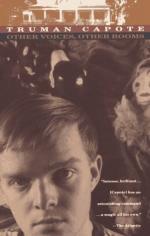|
This section contains 11,718 words (approx. 40 pages at 300 words per page) |

|
SOURCE: “Camping the Gothic: Que(e)ring Sexuality in Truman Capote's Other Voices, Other Rooms,” in Journal of Homosexuality, Vol. 39, No. 1, 2000, pp. 107–38.
In the following essay, Mitchell-Peters considers the portrayal of homosexuality in Other Voices, Other Rooms, focusing on the function of Camp and Southern Gothic style on the novella.
Introduction
With possible influence from the utopian “greenwood” of E. M. Forster's Maurice, originally written from 1913 to 1914 and first published posthumously in 1971, Truman Capote released his first novel in the late 1940s with a striking never-never land that provided an alternative to the stifling realities for homosexuality during this time. There are three settings that exist in this text: the first is a typically redneck Southern backdrop filled with the necessary types and Capote's campy satire, the second is a mysterious rundown mock-haunted castle where the adult homosexuals and/or drag queens hide, and the third is a...
|
This section contains 11,718 words (approx. 40 pages at 300 words per page) |

|


